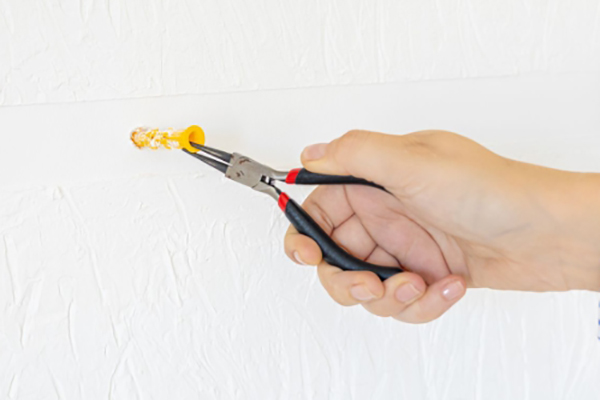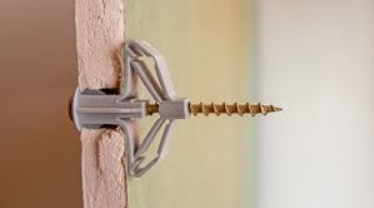This article provides a comprehensive guide on whether or not drywall anchors can be reused. We’ll explore the different types of drywall anchors, the factors influencing reusability, and safe removal techniques. It’s worth reading because understanding these factors can save you time, money, and potential wall damage during your next home improvement project. Whether you’re a seasoned DIY enthusiast or a beginner homeowner, this guide will equip you with the knowledge to make informed decisions about reusing drywall anchors.
What Are Drywall Anchors and Why Are They Used?
Drywall anchors are essential fasteners used in home improvement and construction to securely hang objects on drywall, where a simple screw would likely fail. Drywall is a relatively soft material, and a screw driven directly into it can easily pull out, especially when supporting heavier items. Anchors provide a more secure hold by distributing the weight of the object over a larger area behind the drywall. They create a stronger grip, preventing the screw from ripping out and causing damage.
Think of it like this: trying to hang a heavy picture with just a nail in drywall is like trying to hold a heavy bag with a thin thread. It’s likely to break. A drywall anchor is like using a thicker, stronger rope that spreads the weight and prevents the thread from snapping. These seemingly small devices are critical for mounting items like shelves, mirrors, TVs, and cabinets securely to your walls.
Can All Types of Drywall Anchors Be Reused?
The short answer is no. Whether you can reuse drywall anchors depends on the type of anchor and how it was installed and removed. Some drywall anchors are designed for single-use, while others are designed to be reusable. Understanding the different kind of drywall anchors is crucial to determining their reusability.
Generally, anchors that rely on expansion within the wall cavity, like plastic expansion anchors, are less likely to be reusable. Once they expand, removing them often damages the anchor, making it unreliable for a second use. On the other hand, some anchors, like certain types of threaded drywall anchors, can be reused if removed correctly and without damaging the anchor or the drywall. The key question is whether you can reuse the specific type you’re working with.
How Does the Anchor’s Material Impact Reusability?
The material of the anchor plays a significant role in its reusability. Metal anchors generally tend to be more durable and potentially reusable than plastic ones. Plastic anchors, especially those designed for expansion, can become brittle or deformed during installation or removal, reducing their ability to grip securely if reused.
Metal anchors, such as toggle bolts or some threaded drywall anchors, are often made of sturdier materials like zinc or steel. These materials are less prone to damage during removal, meaning they can potentially be reused if they remain in good condition. However, even metal anchors can be damaged if excessive force is used during removal or if they are corroded. Always inspect the anchor’s condition before attempting to reuse it.
What Role Does the Weight Capacity Play in Reusing Anchors?
The weight capacity of an anchor is a critical factor to consider, even before thinking about reuse. Anchors have different weight ratings, and exceeding that rating, whether during the initial use or a subsequent one, can lead to anchor failing. Reusing an anchor that has previously held a heavy load might have weakened its structural integrity, even if it appears visually undamaged.
Before reusing a drywall anchor, consider the weight of the object you intend to hang. If the new object is significantly heavier than the previous one, it’s best to use a new anchor with an appropriate weight capacity. Even if the weight is similar, remember that the old anchor may have been stressed during its previous use and might not support as much weight as it did originally. It is also wise to take a look at our products, such as Nut, which can be a good substitute.
How to Safely Remove Drywall Anchors for Potential Reuse
The key to potentially reusing a drywall anchor is removing it without causing damage to the anchor itself or the surrounding drywall. The specific removal technique will vary depending on the type of anchor, but the general principle is to be gentle and avoid excessive force.
For threaded drywall anchors, the process is usually straightforward: simply use a screwdriver to unscrew the anchor from the wall. For expansion anchors, you may need to gently hammer the anchor further into the wall to release the expansion mechanism before pulling it out. For toggle bolts, you’ll need to remove the screw and then carefully maneuver the toggle wings to collapse them so they can be pulled back through the hole in the wall.
Step-by-Step Guide: Removing Different Types of Anchors
Let’s break down the removal process for common types of drywall anchors:
-
Threaded Anchors:
- Use a screwdriver that matches the screw head.
- Slowly turn the screwdriver counterclockwise to unscrew the anchor.
- Once the anchor is loose, gently pull it straight out of the wall.
-
Plastic Expansion Anchors:
- First, remove the screw.
- Gently tap the head of the anchor to loosen the flukes of the anchor in the wall.
- Use pliers or your fingers to carefully pull the anchor straight out. If it’s stuck, try wiggling it gently from side to side.
-
Toggle Bolts:
- Remove the screw completely.
- Push the toggle bolt wings together.
- Carefully pull the toggle back through the hole. This might require some maneuvering.
-
Molly Bolt:
- Loosen the bolt by turning it counterclockwise. This will retract the anchor‘s expanding mechanism slightly.
- Once the bolt is loose, but not fully removed, gently tap the head of the bolt with a hammer. This should push the anchor‘s sleeve further into the wall, allowing you to remove the bolt and then the sleeve. A utility knife can sometimes help to free the anchor.
What are the Risks of Reusing Drywall Anchors?
While reusing a drywall anchor might seem like a cost-effective and convenient option, there are potential risks involved:
- Reduced Holding Strength: Reusing an anchor, especially expansion types, can significantly reduce its holding capacity. The anchor may have been weakened or deformed during its initial installation or removal, making it less reliable.
- Wall Damage: A reused anchor that fails is more likely to cause damage the drywall, creating a larger hole and potentially requiring more extensive repairs.
- Anchor Failing: The most significant risk is the anchor failing to support the weight of the object, leading to the object falling and potentially causing damage or injury.
When Should You Absolutely NOT Reuse a Drywall Anchor?
There are specific situations where you should never reuse a drywall anchor:
- Visible Damage: If the anchor is cracked, bent, deformed, or shows any signs of wear and tear, discard it.
- Expansion Anchors (Generally): Most expansion anchors, especially plastic ones, are designed for single-use. Trying to remove and reinstall them often damages the expansion mechanism.
- Uncertain History: If you don’t know how the anchor was previously used or what weight it supported, it’s best to err on the side of caution and use a new anchor.
- Heavy Loads: For heavy objects like large mirrors or TVs, always use a new anchor with an appropriate weight rating.
Alternatives to Reusing Drywall Anchors: Choosing the Right Fixings
Instead of reusing drywall anchors, consider these alternatives:
-
New Drywall Anchors: This is the safest and most reliable option, especially for heavier items or when you’re unsure about the condition of an old anchor.
-
Using a Stud: If possible, locate a wall stud and attach the object directly to the stud using wood screws. This provides the strongest possible support.
-
Specialized Mounting Systems: Some products are designed specifically to be heavy-duty, such as Self-drilling Hollow Anchor.
-
Move the object: If you’re simply repositioning something, could the new position use a wall stud?
FAQs: Reusing Drywall Anchors
Q: Can I reuse plastic expansion anchors?
A: Generally, it’s not recommended. Plastic expansion anchors are typically designed for single-use and are prone to damage during removal.
Q: Can I reuse threaded drywall anchors?
A: Yes, if they are in good condition and removed carefully. Inspect them for any damage before reusing.
Q: How do I know if an anchor is safe to reuse?
A: Look for any signs of damage, such as cracks, bends, or deformation. If in doubt, don’t reuse it.
Q: What’s the best way to remove a drywall anchor without damaging the wall?
A: Use the appropriate removal technique for the type of anchor. Be gentle and avoid excessive force.
Q: Can I use a larger screw in an old anchor hole?
A: No, you run the risk of damaging the wall and weakening the hold.
As a good alternative, check out our Shank adapters.
Expert Insight from China
As Allen from China, a manufacturer of self-drilling anchor systems and drilling tools, I can offer a unique perspective. We at Jiufu focus heavily on the durability and quality of our products. We supply to major markets like the USA, North America, Europe, and Australia, catering to construction, mining, and tunneling companies.
Our self-drilling anchors, for example, are designed for efficiency and ease of installation. These are not typically reusable in the traditional sense, as the drilling process integrates the anchor with the surrounding material. However, the quality of the materials we use ensures that they provide a secure and long-lasting hold, minimizing the need for frequent replacements.
From working with clients like Mark Davis in the USA, I’ve learned that while cost-effectiveness is crucial, quality and reliability are paramount. The pain points Mark experiences—communication inefficiencies, shipment delays, and certificate fraud—are issues we actively address through transparent communication, robust logistics, and stringent quality control, including adherence to ISO standards.
We believe in providing not just products but solutions. Our extensive range, from anchor bars and anchor bits to split set rock bolts and fiberglass bolts, ensures that our clients have access to the right tools for their specific needs. And while some components, like anchor nuts and anchor plates, might be considered for reuse under specific conditions and careful inspection, we always emphasize using the right anchor for the job to guarantee safety and performance.
In the context of the B2B market and exporting to demanding markets, understanding the nuances of product application, including when and how to reuse components (where applicable), is vital. It’s about balancing cost-saving measures with the unwavering commitment to safety and structural integrity.
Summary: Key Takeaways on Reusing Drywall Anchors
- Not all drywall anchors are reusable.
- Expansion anchors (especially plastic ones) are generally single-use.
- Threaded drywall anchors can be reusable if in good condition.
- Always inspect an anchor for damage before reusing it.
- Never reuse an anchor if you’re unsure of its history or if it will be supporting a heavy load.
- The safest option is to use a new anchor with an appropriate weight rating.
- Gently does it, do not force the anchor.
- Reuse only when absolutely necessary.
- Choose the right size and the right type, when in doubt don’t reuse.
- Consider where you are putting the fixture, can you put it into a stud to provide additional support?
Post time: 3 月-25-2025
















